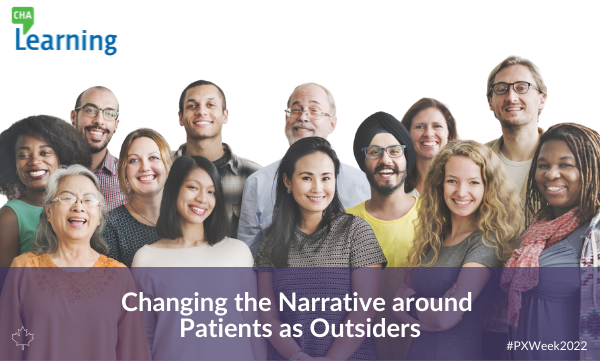This article is part of a series of articles on the topic of People-Centred Care originally published on LinkedIn as part of Beryl Institute’s Patient Experience Week 2022.
You can find the original LinkedIn article here.
—
Today’s post will be a bit shorter, but it’s extremely important and something I feel very passionately about. It’s about changing the narrative about how we (the health system) often judge and label patients. Look out for the self-reflection/discussion question at the end of the post.
There are two elements to this I want to explore:
- How the label “patient” impacts experience and care
- How patients have traditionally been seen as “outsiders” of the health system and the impact this has on their experiences and on care.
How does the label ”patient” impact experience and care?
The word patient is familiar and logical to those of us who have worked in the health system for any length of time. It defines a person who needs health care services of one kind of another. But, when every person coming to your hospital is “just a patient” and all patients are lumped together as if their needs, preferences, lives and contributions are the same, this really takes away from the value and the uniqueness of each of those individuals and their families. And while I’m not suggesting we need to completely change our language (nor would I think I’d have the power to influence that!), I think that being mindful of our language and how this can impact behaviour is critically important, so that we can change the meaning behind the word and change the way we interact with and see our ‘patients’.
One of the greatest dangers of labelling a person a patient is to put them in a box which limits their individuality and prevents us from knowing them as a whole person. It creates assumptions on the part of staff and clinicians that all patients are the same, and of course, that is just not true. Even for people who have the same health conditions and treatment journeys, they are unique and so is their experience. Every person’s experience of an individual episode of care or a care journey will be different.
Labelling a person and minimizing them as ‘just a patient’ takes away their humanness. It leads to the devaluing of their life experiences, their ability to understand their health and health care, and it limits or prevents us from providing people-centred care in true partnership. It supports the traditional, paternalistic models of care delivery and the imbalance of power between the health system and those using it.
When a person arrives at a healthcare appointment to discuss their recent diagnostic tests and a cancer diagnosis, the conversation that ensues should be as unique as they are. There are so many factors that impact a person’s needs and preferences regarding the information they want, how they would like that information shared with them, who they want to be present, and what they will do with the information when they leave the appointment. Factors such as previous experiences, literacy level, education, socioeconomic status, family situation, cultural background, mental and physical health are just a few examples of what shapes a person’s needs and preferences in a healthcare situation. What if the person has an invisible learning disability? They may not feel comfort to share this with their provider or speak up and ask questions if they do not understand something. How does the clinician know if the person understands what is being shared with them?
Aside from the individual care level, seeing people for their entirety of their lives and experiences rather than ‘just a patient’ gives rise to phenomenal opportunities for us to improve our health system. This is really where the language of ‘people with lived experience’ starts to make the most sense. The education, work experience, life experience that people bring to the table can help us see our health system, our processes, our service delivery in a very different light and contribute knowledge and skills the healthcare team may not have. A person with a process engineering background can help support quality improvement initiatives while also bringing their experience as a patient to the table. A person who is a teacher can help us develop PCC education programs for staff. A person veteran who has experienced PTSD can help us design and delivery peer-to-peer support programming. There is no end to the possibilities for partnership and co-design if we see each patient partner as the sum of all of their unique experiences, expertise and strengths. Patients (and/or their families) should ALWAYS be seen as the expert and the driver when it comes to their own health and healthcare.
Patients as outsiders
Another structural bias that needs to be broken down and changed is the idea of the patient as an ‘outsider’. This concept relates very closely to the last point about seeing people as the sum of their parts rather than “just” a patient.
Traditionally, the view has been that patients who do not work in the health system can’t possibly understand the way it works; the reasons why things are structured a certain way, the challenges that healthcare workers face, the barriers to change. Because of this, patients have been often seen as partners, just passive recipients of care. Anyone who has not received clinical training could not possibly understand the care options put before them and engage in shared decision making. Patients are not equipped to sit at a table with healthcare leaders or staff to input into service design because they lack context and knowledge of our complex system. I would argue that these long-held views stem largely from fear.
Fear is a natural human emotion and can be an inhibitor of thoughtful behaviour. Fear is a protective emotion. Fear can also emerge when individuals or groups feel threatened by change.
In the context of people-centred care, fear can impact peoples’ willingness to change or see things differently in terms of inviting patients and families in as partners, as they may:
- Feel their livelihood is threatened
- Perceive a loss of power or control
- Feel they are not up to the challenge (e.g., don’t have the skills to cope with the new approach)
- Perceive their professional status or autonomy being challenged
(CHA Learning, 2019)
Sometimes, fear simply comes from misunderstanding of the change being implemented. This highlights again the need for effective communication and leadership to ensure that the rationale and impacts of PCC are very clear, that ample opportunities for questions and discussion are provided and that myths and misconceptions are addressed quickly.
The view of patients as outsiders without the requisite knowledge to help shape health system and health service improvement is changing and those organizations who embrace the value that patients bring to our system are benefiting greatly. In our People-Centred Care Program we showcase examples of organizations who have truly embraced co-design and have seen incredible results. To do so, people have to see patients and families as equal contributors. One of those examples is St. Joseph’s Healthcare in London, ON, who used Experience Based Co-Design to improve family caregiver involvement, education and support and improve transitions in care in their large, multi-site organization (pre-pandemic).
It’s also important to consider that indeed, patient partners may need some foundational training to help them understand aspects of the health system, the specific organization, or the project they are a part of; training and education is an important part of a patient partnership strategy.
I would challenge you personally to take one step towards changing these narratives. Whether you are a direct care provider or not, start to look at every person who enters your healthcare organization as the sum of their whole life rather than ‘just a patient’. Become curious about who they are and what strengths, knowledge and perspectives (or fears and needs) they bring with them.
This topic is also touched on in the inspiring podcast episode with Jacqueline Per, Executive Director of Research and Innovation at Fraser Health in BC on the Future of Our Health Workforce. Check out the podcast here.
Tomorrow, I’ll talk about patient and family experience, satisfaction and how organizations need to prioritize patient and family experience like other aspects of their strategy.
Today’s reflection or discussion question: As someone who works within the healthcare system, are you aware of an unconscious or conscious bias you hold about patients being outsiders of the health system? What is one thing you can do to help break that bias?





